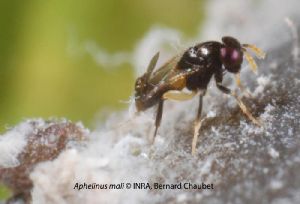Aphelinidae

Aphelinus mali adult
General description
| Classification |
Insect - Hymenoptera - Aphelinidae |
|---|---|
| Description |
Microhymenoptera (0.7 to 1.1 mm) with a black body, yellow abdomen at the base, yellow antennae with a blackish pedicel, black front and median legs, yellow tips of the femora and tibiae |
| Type ofauxiliary |
Aphelinus Mali is a specialised parasitoid of the woolly apple aphid. |
| Area of occurrence |
Metropolitan France |
| Crops concerned and host plants |
Apple, Pear, Quince |
Biology and epidemiology
| Stage | Food | Habitat | Other survival conditions | Favourable and optimal conditions for development | Period |
|---|---|---|---|---|---|
|
Pupa |
|
Parasitizedwoolly adelgid |
|
|
Winter |
|
Larvae |
Aphids |
Aphids |
|
|
|
|
Adult |
Aphids |
|
|
When temperatures are above 25°C. They are therefore more active in warmer regions.To encourage their action, avoid using toxic products during the 1st generation(April). |
1st generation in AprilThe following generations, from June to early August, overlap with the 1st generation. |
Comments and possible clarifications :
The females of this hymenoptera lay their eggs directly in woolly aphids. Each female parasitises between 60 and 100 aphids per year. Eggs laid in the adult and final larval stages do not kill the aphid, which can still produce partial offspring. Approximately 10 generations per year.
The woolly adelgid population evolves much faster than that of Aphelinus mali (more generations per year, more offspring, shorter cycle). High populations are difficult to regulate because the aphid "layers" above protect the individuals below.
In the field
Assessing presence
Place yellow sticky plates from early April, identify with binoculars.
Conditions of effectiveness
The action of this beneficial insect should always be complemented by the presence of forficulae, which are major consumers of aphids.
Population required to control pests and diseases
Unknown
Sensitivity to chemical families
It is recommended to limit the use of chemical families to which the beneficials are sensitive so as not to limit their population.
See the e-phy page associated with this beneficiary.
For further information
BAYER
Technical brochure
E-phytia
Website
Encyclop'Aphid
Website
ITAB (by Charles de Schaetzen, GORSEM Royal Research Centre)
Technical brochure
See page 31 onwards
Plant protection dossier - ECOFRUIT 2010
GRAB (Claude Eric Parveaud, François Warlop)
Technical brochure
Resource persons
Charles de Schaetzen, Royal Research Centre Gorsem, Belgium
Claude-Eric Parveaud, GRAB Valence, France
François Warlop, GRAB Avignon
Annexes
Régule les bioagresseurs